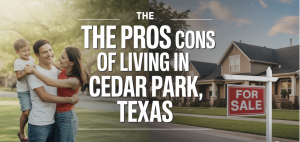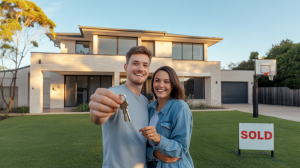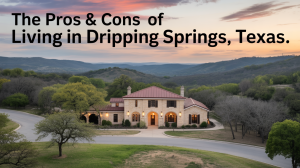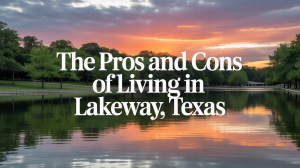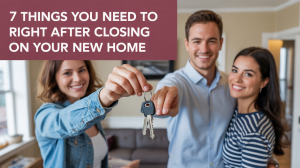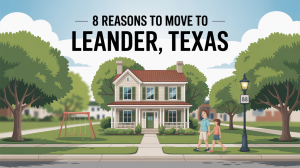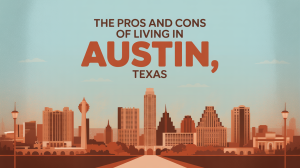Austin, Texas, is increasingly recognized as a city embracing cycling as a primary mode of transportation and recreation. With a growing network of bike lanes, trails, and a vibrant cycling culture, several neighborhoods stand out for their exceptional bikeability. This article explores the top 10 most bikeable neighborhoods in Austin, highlighting their unique cycling infrastructure, amenities, and overall characteristics that make them a cyclist’s paradise.
Austin’s Commitment to Cycling
Austin has made significant strides in developing its cycling infrastructure, earning a Bike Score rating of 54, indicating it is a bikeable city. The city boasts over 215 miles of bike lanes, with 30 miles protected, and a bike-share program, B-cycle, with more than 50 locations and 400 bikes [1]. The city’s comprehensive Austin Bicycle Plan aims to create a complete bike network where people of all ages and abilities can experience biking as safe, comfortable, convenient, and fun [2].
The Top 10 Bikeable Neighborhoods in Austin
Based on various factors including bike score, infrastructure, and amenities, the following neighborhoods are considered the most bikeable in Austin:
| Rank | Neighborhood | Bike Score |
|---|---|---|
| 1 | Holly | 94/100 |
| 2 | Hyde Park | 94/100 |
| 3 | West University | 94/100 |
| 4 | Downtown Austin | 93/100 |
| 5 | North Loop | 93/100 |
| 6 | East Cesar Chavez | 93/100 |
| 7 | North University | 92/100 |
| 8 | Chestnut | 90/100 |
| 9 | Hancock | 90/100 |
| 10 | Old West Austin | 85/100 |
1. Holly
Holly, located along the Colorado River, is a captivating older neighborhood with excellent access to the Lady Bird Lake Hike & Bike Trail. It boasts a Bike Score of 94/100, making it a biker’s paradise The neighborhood, often grouped with East César Chavez, features the Southern Walnut Creek Trail (7.3 miles of concrete path) and the new Country Club Creek Trail. Its flat terrain and proximity to East Austin’s vibrant art and food scene, along with B-cycle stations, make it ideal for both commuting and recreational rides.
Holly sits along the north bank of the Colorado River (Lady Bird Lake) in East Austin. It’s bordered roughly by Chicon Street to the west, 7th Street to the north, Pleasant Valley Road to the east, and the river to the south. It’s often mentioned alongside East César Chávez, as the two neighborhoods blend naturally into each other.
Character & Lifestyle
Holly has a mix of old-school East Austin charm and modern energy. You’ll find a combination of renovated bungalows, new infill homes, and small local businesses tucked into tree-lined streets. The vibe is relaxed and creative — part residential, part artsy, part foodie haven.
The neighborhood’s flat terrain makes it easy to walk or bike just about anywhere. Access to the Lady Bird Lake Hike & Bike Trail is one of Holly’s biggest perks, along with nearby trails like the Southern Walnut Creek Trail and the Country Club Creek Trail.
Public transportation is solid, with several CapMetro routes running through the area. You’ll also find B-cycle stations, plenty of sidewalks, and quick access to downtown — it’s about a five-minute drive or a 10-minute bike ride.
Parks and green spaces are sprinkled throughout, including Metz Park, Fiesta Gardens, and Pan American Park. These spots host community festivals and weekend workouts and offer great river views.
Real Estate & Trends
Holly has transformed over the last decade from a modest working-class neighborhood into one of Austin’s trendiest zip codes. Homes vary widely — from original 1940s cottages to sleek new builds — but prices have climbed sharply.
Recent data puts median home values in the $600K–$700K range, depending on proximity to the lake and downtown. The area’s popularity has also led to higher property taxes and ongoing redevelopment. Gentrification is a real and visible force here, changing both the look and feel of the neighborhood.
Why People Love Holly
-
Biker’s paradise: With a Bike Score around 94/100, Holly is one of the most bike-friendly neighborhoods in Austin.
-
Central location: You can be downtown, on South Congress, or at a riverside trail in minutes.
-
Local flavor: From coffee shops and taco stands to new farm-to-table restaurants, the food scene is rich and varied.
-
Character: Despite rapid development, Holly still has pockets of its original East Austin spirit — colorful homes, murals, and long-time residents who know everyone on the block.
-
Community: The neighborhood association and residents are active in preserving the area’s identity and green spaces.
Things To Consider
-
Rising costs: Homes and rents have climbed steeply, pricing out many long-term locals.
-
Traffic and noise: Its proximity to East 6th and popular nightlife spots means weekends can get busy and loud.
-
Mixed infrastructure: Some streets lack complete sidewalks or have narrow roads, especially in older sections.
-
Flood risk: Parts near the river sit in lower-lying areas that can flood during heavy rains.
In short, Holly blends the best of Austin’s creative side with the convenience of city living. It’s ideal for anyone who loves biking, local food, and living within minutes of downtown — but it comes with a higher price tag and the growing pains of gentrification.
2. Hyde Park
Hyde Park, a historic and culturally rich neighborhood in Central Austin, also scores 94/100 for bikeability. It is designated as a neighborhood bikeway route, with projects like the 46th-47th Streets and Bennett-Middle Fiskville Bikeway enhancing its cycling infrastructure. Bike lanes are readily available, and its proximity to the Shoal Creek Trail further adds to its appeal. Hyde Park offers a laidback, family-friendly atmosphere with historic homes and local businesses, making it a pleasant area for cyclists.
Hyde Park Neighborhood Overview
Location:
Hyde Park is one of Austin’s most historic and recognizable neighborhoods, sitting just north of the University of Texas campus and stretching between Guadalupe Street and Duval Street. It’s part of Central Austin, giving residents a quick commute to downtown while maintaining a quiet, residential feel.
Character & Lifestyle
Hyde Park has a cozy, small-town vibe in the middle of the city. The streets are shaded by old oak trees and lined with charming early 20th-century homes — many of them beautifully preserved Victorians and Craftsman-style bungalows. The neighborhood’s personality is relaxed and community-oriented, with long-time residents, students, and young families sharing the same blocks.
There’s a strong local presence here. Coffee shops, small grocers, and beloved restaurants like Hyde Park Bar & Grill and Antonelli’s Cheese Shop give it a warm, neighborhood feel. Sidewalks are wide, and the community encourages walking and cycling over driving.
Biking & Walkability
Hyde Park earns a Bike Score of 94/100, making it one of the most bikeable neighborhoods in Austin. It’s officially designated as a neighborhood bikeway route, with continuous improvements like the 46th–47th Streets and Bennett–Middle Fiskville Bikeway enhancing safe cycling through the area.
Bike lanes are common throughout Hyde Park, and riders can easily connect to the Shoal Creek Trail, which provides a scenic route into downtown and beyond. The flat terrain, slow traffic, and abundance of shaded streets make it ideal for everyday cycling or leisurely rides.
Real Estate & Architecture
Homes in Hyde Park tend to hold their value thanks to its central location and historic appeal. Expect a mix of well-kept older homes, modernized remodels, and small apartment buildings that blend with the neighborhood’s character. Median home prices typically range from the $700K–$900K mark, depending on size, updates, and proximity to major streets.
Because of preservation efforts, new construction is limited, which helps maintain the neighborhood’s charm but also keeps housing inventory tight.
Why People Love Hyde Park
-
Historic charm: Turn-of-the-century homes, mature trees, and quiet residential streets.
-
Central convenience: Only minutes from downtown, UT Austin, and major employers.
-
Bike-friendly: Excellent infrastructure and connections to citywide trails.
-
Community feel: Walkable blocks, local cafés, and friendly neighbors who know each other by name.
-
Family-oriented: Great parks, sidewalks, and schools nearby.
Things To Consider
-
Limited parking: Some older homes and narrow streets can make parking tricky.
-
High demand: Homes don’t stay on the market long, and prices reflect the neighborhood’s desirability.
-
Older infrastructure: Many properties are historic, so buyers should be mindful of renovation or maintenance needs.
In short, Hyde Park is perfect for anyone who loves Austin’s old-fashioned character but still wants the convenience of central city living. With its bike-friendly design, leafy streets, and strong sense of community, it feels like a peaceful pocket of history surrounded by modern life.
3. West University Area
The West University Area, adjacent to the University of Texas campus, is a cyclist’s dream with a Bike Score of 94/100. It features bike lanes on major streets like Guadalupe and 24th, the 3.9-mile Shoal Creek Greenbelt trail, and convenient bike repair stations. The presence of shielded bike lanes on main roads and numerous B-cycle stations underscores its commitment to cycling. Its flat terrain and vibrant, dense urban feel, largely influenced by the student population, create a bike-friendly environment with plenty of coffee shops and restaurants.
West University Area Neighborhood Overview
Location:
The West University Area, often called “West Campus,” sits directly west of the University of Texas at Austin. It’s bounded by Guadalupe Street on the east, Lamar Boulevard on the west, 29th Street to the north, and Martin Luther King Jr. Boulevard to the south. This location makes it one of the most central and energetic neighborhoods in the city — just minutes from downtown and the UT Tower.
Character & Lifestyle
West University has a distinctly urban, youthful energy shaped by its proximity to UT. The streets buzz with students walking, biking, and hanging out at local coffee shops, taco joints, and late-night eateries. You’ll find a mix of high-rise student housing, older apartment buildings, and some remaining single-family homes that date back several decades.
While it’s known for its dense, college-town vibe, West University also offers pockets of quiet residential charm, especially along its western edges near Lamar and the Shoal Creek Greenbelt. The area blends convenience with culture — everything you need is within a few blocks, from grocery stores and gyms to bars and bookstores.
Biking & Accessibility
The West University Area has a Bike Score of 94/100, putting it among Austin’s top neighborhoods for cycling. The terrain is flat, and major streets like Guadalupe, Rio Grande, and 24th Street have designated or protected bike lanes, making it easy and safe to navigate on two wheels.
Cyclists can access the Shoal Creek Greenbelt Trail, a 3.9-mile route that runs along the creek and connects to other central trails for longer rides. The neighborhood also features several B-cycle stations and public bike repair stands — a big plus for students and commuters alike.
Because parking can be tight and traffic is constant around campus, many residents rely on bikes as their main mode of transportation. This has helped create one of the most consistent cycling cultures in Austin.
Real Estate & Housing
Housing in West University is largely student-oriented. Expect a wide range of apartments, condos, and shared housing options, many within walking distance to campus. Rents are generally higher than average due to location, but the convenience factor — being able to walk or bike everywhere — makes up for it.
Recent years have brought more modern mixed-use developments, but older buildings still dominate many blocks, giving the area a lived-in, classic Austin character. While not a quiet suburb by any stretch, it’s ideal for those who want to be in the heart of the action.
Why People Love West University
-
Unbeatable location: Steps from UT Austin and minutes from downtown.
-
Biker’s dream: Flat streets, protected bike lanes, and trail access make cycling fast and safe.
-
Vibrant energy: A mix of students, young professionals, and longtime locals keeps the area lively year-round.
-
Walkable lifestyle: Cafés, bookstores, grocery stores, and bars all within a few blocks.
-
Strong community vibe: Despite its density, it’s a place where people recognize each other on daily rides and walks.
Things To Consider
-
Noise and traffic: The area is active day and night, especially during the school year.
-
Limited parking: Owning a car can be inconvenient here.
-
Student-centric atmosphere: The youthful energy is great for some but may not suit everyone.
-
High demand for rentals: Units close to campus fill quickly, and turnover is frequent.
In short, the West University Area is Austin’s biking and walking hub — dense, flat, and full of energy. It’s perfect for anyone who loves being close to the university, the trails, and the city’s fast-paced, creative pulse.
4. Downtown Austin
Downtown Austin, with a Bike Score of 93/100, has significantly improved its cycling infrastructure. The Lance Armstrong Bikeway connects downtown to East Austin, and Congress Avenue features protected bike lanes. Over 50 B-cycle stations are available, making it easy to navigate the compact urban core. Cyclists can easily reach attractions like the State Capitol and Lady Bird Lake, enjoying a vibrant urban environment.
Downtown Austin Neighborhood Overview
Location:
Downtown Austin sits at the heart of the city, bordered roughly by the Colorado River (Lady Bird Lake) to the south, Martin Luther King Jr. Boulevard to the north, I-35 to the east, and Lamar Boulevard to the west. It’s the city’s business, cultural, and entertainment center — home to everything from high-rise condos and historic landmarks to live music venues and parks.
Character & Lifestyle
Downtown Austin is a blend of Texas history and modern energy. The area buzzes with activity day and night — office workers during the week, festival-goers and locals on weekends, and a steady rhythm of live music spilling out of bars, patios, and rooftop lounges.
Despite the urban density, downtown has a surprising number of green spaces and trails. The Lady Bird Lake Hike & Bike Trail runs along its southern edge, offering miles of waterfront paths perfect for cycling, jogging, or walking your dog at sunrise.
Living here means convenience at every turn — restaurants, markets, gyms, and entertainment are all within walking distance. The atmosphere is upbeat and sophisticated, attracting young professionals, entrepreneurs, and anyone who wants to be in the middle of Austin’s action.
Biking & Accessibility
Downtown Austin earns a Bike Score of 93/100, reflecting major investments in cycling infrastructure over the past decade. The Lance Armstrong Bikeway connects downtown to East Austin, providing a safe, direct route for commuters and recreational riders alike.
Congress Avenue now features protected bike lanes, and many of the city’s busiest streets include buffered or designated cycling paths. There are also more than 50 B-cycle stations throughout downtown, making short trips and spontaneous rides easy without owning a bike.
The area’s compact layout means most destinations — from the State Capitol to Lady Bird Lake — are just a few minutes apart by bike. Traffic can be heavy, but the growing network of protected lanes helps keep cyclists safer and more visible.
Real Estate & Housing
Downtown Austin is home to some of the city’s most luxurious real estate. High-rise condos dominate the skyline, offering sweeping lake or city views, rooftop pools, and walkable access to everything. Prices reflect the demand — it’s one of Austin’s most expensive areas to live.
While single-family homes are virtually nonexistent here, there are options ranging from micro-apartments to penthouse suites. Many newer developments focus on mixed-use living, combining retail, restaurants, and residences in one building.
Why People Love Downtown Austin
-
Active lifestyle: Bike, walk, or scooter anywhere — no car needed.
-
Scenic rides: Quick access to Lady Bird Lake and the Hike & Bike Trail.
-
Urban convenience: Dozens of restaurants, shops, and live music venues steps away.
-
Energy and culture: The heart of Austin’s festivals, nightlife, and creative scene.
-
Sustainability focus: Expanding network of protected bike lanes and B-cycle stations.
Things To Consider
-
Cost of living: Housing, dining, and parking come at a premium.
-
Traffic and noise: Expect a lively environment, especially on weekends and event nights.
-
Limited parking: Most residents rely on garages, paid lots, or ditch the car altogether.
-
Construction: Ongoing development means cranes and new projects are a constant sight.
In short, Downtown Austin offers a vibrant, bike-friendly urban lifestyle with unmatched access to the city’s best attractions. It’s ideal for those who thrive on movement, music, and modern city living — all within a few pedal strokes of the lake.
5. North Loop
North Loop scores 93/100 for bikeability and is actively enhancing its cycling infrastructure. Recent improvements include protected bike lanes on North Loop Boulevard (between Burnet and Lamar) and plans for intersection safety upgrades. The neighborhood offers a unique blend of homes, trendy coffee shops, and local eateries. Its urban feel, diverse housing options, and walkable streets contribute to a welcoming environment for cyclists.
North Loop Neighborhood Overview
Location:
North Loop is a lively, eclectic neighborhood located in North Central Austin, roughly bordered by Koenig Lane to the south, Airport Boulevard to the east, and Lamar Boulevard to the west. It sits just a few miles north of downtown and near major corridors like I-35 and Highway 290, making it convenient for both commuters and creatives.
Character & Lifestyle
North Loop has long been one of Austin’s most personality-filled neighborhoods — a mix of mid-century homes, funky vintage stores, and locally owned coffee shops that reflect the city’s laid-back charm. The atmosphere is urban yet unpretentious, and residents range from young professionals and artists to long-time locals who’ve seen the area evolve.
Walk down North Loop Boulevard, and you’ll find quirky boutiques, vinyl shops, food trucks, and cafes buzzing with people working on laptops or catching up over cold brew. It’s a neighborhood that feels distinctly “old Austin,” with just enough modernization to make life convenient without losing its soul.
Biking & Accessibility
With a Bike Score of 93/100, North Loop continues to improve its cycling network and safety. The city has recently added protected bike lanes along North Loop Boulevard, between Burnet and Lamar, creating a safer route for daily commuters and casual riders. Upcoming plans include intersection upgrades and additional traffic-calming measures to make biking even more accessible.
The area’s relatively flat layout and short distances to hotspots like Hyde Park, Brentwood, and the Triangle make it easy to get around without a car. It’s also close to several key bike routes that connect to the Shoal Creek Trail and downtown. Whether you’re commuting, cruising to a coffee shop, or running errands, cycling in North Loop feels practical and enjoyable.
Real Estate & Housing
North Loop offers a mix of 1950s bungalows, remodeled ranch homes, and small apartment complexes, giving it a casual, lived-in character. The homes are smaller compared to newer builds in other parts of Austin, but that’s part of the charm — and the prices tend to be more approachable for buyers who want to stay near the city center.
As demand in nearby areas like Hyde Park and Brentwood has grown, North Loop has become a favorite alternative for those seeking a creative, community-driven neighborhood with a slightly lower price tag.
Why People Love North Loop
-
Strong bike culture: Safe, protected lanes and easy access to nearby trails.
-
Local flavor: Vintage shops, indie bookstores, and family-owned restaurants.
-
Walkable convenience: Most daily needs and hangouts are within a short stroll or ride.
-
Diverse housing: Mix of old and new homes with approachable prices.
-
Creative energy: A neighborhood that balances nostalgia with new ideas.
Things To Consider
-
Limited parking: Some streets can feel tight, especially near North Loop Boulevard.
-
Older homes: Many properties may need updates or renovations.
-
Noise and traffic: The area stays active, especially around popular hangout spots.
-
Rapid growth: More development is on the way, which could change the local vibe.
In short, North Loop blends Austin’s quirky charm with everyday convenience. It’s a bike-friendly, community-minded neighborhood where creativity thrives — ideal for anyone who wants a mix of urban living and neighborhood warmth without venturing too far from downtown.
6. East Cesar Chavez
East Cesar Chavez, sharing a Bike Score of 93/100 with North Loop and Downtown, is a cycling hotspot [1]. It benefits from the Southern Walnut Creek Trail and the new Country Club Creek Trail. There are also proposals for raised protected bicycle lanes and ongoing efforts to install more bike and transit infrastructure. This diverse and dynamic neighborhood blends urban living with a vibrant culinary and artistic scene, making it an engaging area for cyclists.
7. North University
North University, with a Bike Score of 92/100, offers a residential feel with excellent bike access. It features wide streets with bike lanes and easy access to downtown via Red River Street bike lanes. The neighborhood is also close to the Shoal Creek Trail, with future plans for protected bike lanes on West 34th Street. Its quiet, eclectic atmosphere, combined with proximity to UT and various amenities, makes it popular among students and long-term residents alike.
8. Chestnut
Chestnut, scoring 90/100 for bikeability, is a vibrant part of East Austin. It provides designated bike lanes and accessible routes to key city points. Mobility and safety improvements are underway around Manor Road, Cherrywood Road, and Chestnut Avenue. This laid-back neighborhood is known for its diverse community, numerous bars, restaurants, coffee shops, and parks, offering a sparse suburban feel with urban conveniences.
Chestnut Neighborhood Overview
Location:
Chestnut is a lively and diverse neighborhood in East Austin, situated just north of East 12th Street and east of I-35. It’s bordered by Martin Luther King Jr. Boulevard to the south, Airport Boulevard to the east, and Manor Road to the north. Its central location places it within minutes of downtown, the University of Texas campus, and Mueller, making it one of the city’s most accessible areas.
Character & Lifestyle
Chestnut has a relaxed, residential atmosphere paired with the creative energy that defines East Austin. The neighborhood features a mix of historic bungalows, modern infill homes, and small apartment complexes, all surrounded by mature trees and friendly streets. The vibe is unpretentious — it’s the kind of place where you’ll see people chatting on porches, kids riding bikes, and neighbors gathering at local coffee shops.
Its proximity to Manor Road gives residents access to some of East Austin’s best restaurants, bars, and cafés, while nearby parks and trails make it easy to spend time outdoors. The area continues to evolve, but it’s managed to retain a strong sense of community and cultural identity throughout its growth.
Biking & Accessibility
With a Bike Score of 90/100, Chestnut is one of the most bike-friendly neighborhoods in East Austin. The streets are mostly flat, and there are designated bike lanes that connect riders to nearby areas like Cherrywood, Mueller, and downtown.
Recent city projects have focused on mobility and safety improvements around Manor Road, Cherrywood Road, and Chestnut Avenue, including better bike lane markings, crosswalks, and lighting. These upgrades have made cycling safer and more convenient, whether you’re commuting to work, heading to UT, or cruising to a weekend brunch spot.
Public transit is also strong in this area, with several CapMetro routes and nearby train stations providing quick links to downtown and North Austin.
Real Estate & Housing
Chestnut’s housing market reflects its transition from a quiet residential area to a sought-after East Austin destination. You’ll find an eclectic mix of older single-family homes, newly built modern designs, and renovated properties that balance character with comfort.
Compared to neighborhoods closer to downtown, prices in Chestnut are slightly more accessible, though demand continues to rise as East Austin’s popularity grows. The diversity of housing options — from starter homes to stylish new builds — attracts a wide range of residents, from first-time buyers to young professionals and creatives.
Why People Love Chestnut
-
Bike-friendly: Smooth, well-connected routes to downtown, UT, and surrounding neighborhoods.
-
Community feel: A diverse mix of longtime residents and new arrivals who value neighborhood pride.
-
Urban convenience: Walkable access to coffee shops, restaurants, and nightlife along Manor Road.
-
Laid-back energy: Quieter streets with plenty of green space and parks.
-
Cultural roots: A neighborhood that honors its East Austin heritage while embracing new growth.
Things To Consider
-
Ongoing development: New homes and infrastructure projects can bring construction noise.
-
Property values rising: Increased demand continues to push prices upward.
-
Parking and street width: Some older streets can feel tight when cars line both sides.
-
Mixed architecture: A blend of old and new gives it character, but not everyone loves the contrast.
In short, Chestnut offers the best of both East Austin worlds — a relaxed, community-driven neighborhood with the convenience of city living. With its bikeable streets, cultural richness, and easy access to downtown, it’s a great fit for those who want a balance of local charm and urban energy.
9. Hancock
Hancock, also with a Bike Score of 90/100, is a quaint and quiet neighborhood north of the University of Texas. Significant cycling infrastructure projects include a two-way protected bicycle facility across Hancock Bridge and upgraded protected bike lanes on Bull Creek Road. The neighborhood is home to the Hancock Recreation Center and Golf Course, along with various local amenities, making it a desirable area for professionals and families who enjoy an urban feel.
10. Old West Austin
Old West Austin, with a Bike Score of 85/100, is a historic and centrally located neighborhood. It boasts extensive cycling infrastructure, including bike lanes and easy access to the Pease District Park and Shoal Creek Greenbelt. The neighborhood offers a quiet and relaxing environment with scenic views and mature trees, while still providing convenient access to downtown amenities, including bars, restaurants, and coffee shops. Its preservation of mid-20th century homes adds to its unique charm.
Old West Austin Neighborhood Overview
Location:
Old West Austin sits just west of downtown, bordered by Lady Bird Lake to the south, MoPac Expressway to the west, and 15th Street to the north. It encompasses several historic sub-neighborhoods, including Clarksville, Old Enfield, and Pemberton Heights — all known for their tree-lined streets, timeless architecture, and unbeatable proximity to the city’s core.
Character & Lifestyle
Old West Austin is one of the city’s oldest and most picturesque neighborhoods, blending a peaceful residential feel with easy access to downtown life. The area is defined by its mature oak trees, historic homes, and walkable streets, where neighbors still wave to each other and front porches are part of the social fabric.
Despite being minutes from the energy of downtown, the neighborhood itself feels quiet and calm. You’ll find a mix of early 20th-century homes, mid-century designs, and a few thoughtfully integrated modern builds that respect the area’s historic character.
Old West Austin also sits close to Pease District Park — one of Austin’s oldest green spaces — and the Shoal Creek Greenbelt, offering residents miles of shaded trails perfect for walking, jogging, or biking. On weekends, locals can be found biking to downtown brunch spots, strolling along the creek, or heading to neighborhood cafés like Caffé Medici or Josephine House.
Biking & Accessibility
With a Bike Score of 85/100, Old West Austin is considered highly bikeable. The neighborhood has dedicated bike lanes on several main streets, plus quick connections to the Shoal Creek Trail and Lance Armstrong Bikeway, which lead directly into downtown and beyond.
The relatively flat terrain and low-speed residential streets make cycling both safe and enjoyable. While traffic can pick up near MoPac and Lamar, most of the interior roads remain calm and shaded — ideal for daily commutes or scenic rides through the neighborhood’s historic districts.
Residents also enjoy easy access to nearby parks, downtown offices, and cultural landmarks like the Texas State Capitol and the Blanton Museum of Art — all reachable within a short ride.
Real Estate & Architecture
Old West Austin’s homes are some of the most architecturally distinct in the city. You’ll find Craftsman bungalows, Colonial Revivals, Tudors, and mid-century moderns, many beautifully maintained or restored. Because of its historical significance, parts of the neighborhood are protected under preservation guidelines that limit large-scale redevelopment.
This exclusivity contributes to high demand — and higher prices. Median home values typically range well above $1 million, reflecting both the location and the neighborhood’s charm. Still, the area’s sense of history and tranquility make it one of Austin’s most coveted places to live.
Why People Love Old West Austin
-
Historic beauty: Gorgeous architecture and tree-lined streets with deep roots in Austin’s past.
-
Proximity to downtown: A quick bike or car ride to offices, restaurants, and entertainment.
-
Outdoor access: Steps from Shoal Creek Greenbelt and Pease Park.
-
Peaceful atmosphere: Quiet, established streets just minutes from the city’s buzz.
-
Community pride: Strong preservation efforts maintain the area’s character and charm.
Things To Consider
-
Price point: Homes are among the most expensive in Austin.
-
Limited inventory: Few properties come on the market, and they sell quickly.
-
Older infrastructure: Some homes may require updates to meet modern standards.
-
Parking and traffic: Narrow streets and downtown proximity can make parking tight.
In short, Old West Austin blends the best of both worlds — historic charm and modern convenience. It’s ideal for those who appreciate architecture, green spaces, and a peaceful neighborhood atmosphere, all within minutes of downtown’s restaurants, culture, and nightlife.
Conclusion
Austin’s commitment to fostering a bike-friendly environment is evident in these top neighborhoods. Each offers a unique blend of cycling infrastructure, amenities, and community characteristics that cater to diverse preferences, from urban commuters to recreational riders. As Austin continues to expand its cycling network, these neighborhoods stand as prime examples of successful urban planning that prioritizes sustainable and active transportation.

